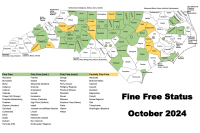A different social butterfly: WCU professor examines insect societies in new book
Mention the phrase “insect society,” and most folks automatically think of such natural phenomena as the bee hive, the ant colony, the wasp nest or the termite mound — structured civilizations characterized by a precise division of labor among their six-legged citizens.
But as James T. Costa, the H.F. and Katherine P. Robinson Professor of Biology at Western Carolina University and director of the Highlands Biological Station, points out in a newly published book, similar social interactions can be seen among other orders of insects.
You might think of it as a whole new definition of the term “social butterfly.”
In The Other Insect Societies, Costa argues that, in their efforts to explain the mysteries of the communal behaviors that have evolved among ants, bees and similar insects, evolutionary biologists have long ignored the diverse social arrangements that exist among the remaining 28 orders.
Published by the Harvard University Press, Costa’s comprehensive 792-page book examines social phenomena from the world of the arthropods — beetles and bugs, caterpillars and cockroaches, mantids and membracids, sawflies and spiders.
“While these other species may not be social in precisely the same way as their more celebrated kin the ant and the bee, many of them exhibit a degree of communal behavior that can be quite sophisticated,” he said. “Many of them have their own intriguing relationships and subtle interdependencies.”
For example, he said, some types of caterpillars assist colony members in foraging for food by laying down a chemical trail that others can follow. When threatened by predators such as birds, some caterpillars will simultaneously assume a defensive position by forming their bodies into U shapes and flicking their posterior and anterior ends in an effort to appear much larger than they are – and less appealing to the predator.
Costa’s interest in the subject of insect societies can be traced to his studies of the social interactions of caterpillars during his days as an undergraduate student at the State University of New York College at Cortland, a fascination that continued as he worked on his master’s and doctoral degrees at the University of Georgia.
Costa holds a continuing appointment as a research associate in entomology at the Museum of Comparative Zoology at Harvard, and was a Fellow of Harvard’s Radcliffe Institute for Advanced Study during the 2004-05 academic year.
He has written extensively on the subject of insect behavior and societies, articles stemming from research conducted with WCU undergraduate and graduate students in Costa Rica and Mexico. He also has guided students doing research in Great Smoky Mountains National Park and at the nearby Highlands Biological Station.
Highlands Biological Station is an interinstitutional center of the University of North Carolina located in Highlands. Founded in 1927, the Highlands Biological Station sponsors research and summer courses focusing on the unique Southern Appalachian natural environment. For more information on the station’s programs and course offerings, see www.wcu.edu/hbs.





